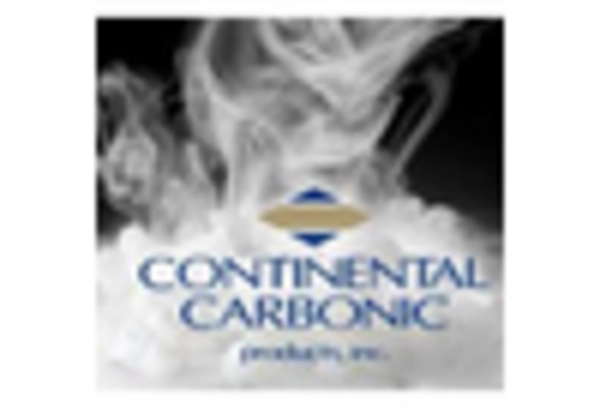Expansion of Cold Chain Logistics
The expansion of cold chain logistics in India is a pivotal driver for the dry ice market. As the demand for temperature-sensitive products increases, particularly in the food and pharmaceutical sectors, the need for effective cooling solutions becomes paramount. The cold chain logistics industry is projected to grow at a CAGR of approximately 20% over the next few years, which directly correlates with the rising consumption of dry ice. This growth is fueled by the increasing number of refrigerated transport vehicles and storage facilities. Consequently, the dry ice market is likely to experience heightened demand as businesses seek reliable methods to maintain product integrity during transit. The ability of dry ice to provide consistent low temperatures makes it an ideal choice for logistics providers, thereby enhancing its market presence in India.
Growth in the Pharmaceutical Sector
The growth in the pharmaceutical sector in India is a crucial driver for the dry ice market. With the increasing production of vaccines, biologics, and other temperature-sensitive medications, the need for reliable cooling solutions is more pronounced than ever. The pharmaceutical industry in India is projected to reach $130 billion by 2030, indicating a robust demand for dry ice as a means of maintaining the efficacy of these products during storage and transportation. Dry ice is particularly valuable for shipping vaccines, which often require ultra-low temperatures. Consequently, the dry ice market is likely to expand as pharmaceutical companies seek dependable methods to ensure the integrity of their products throughout the supply chain.
Rising Awareness of Food Safety Standards
Rising awareness of food safety standards among consumers and regulatory bodies is driving the dry ice market in India. As food safety regulations become more stringent, businesses are compelled to adopt better preservation methods to comply with these standards. The Food Safety and Standards Authority of India (FSSAI) has implemented guidelines that necessitate the use of effective cooling solutions for perishable items. This regulatory environment is likely to propel the demand for dry ice, as it is recognized for its ability to maintain low temperatures and prevent spoilage. The dry ice market is thus expected to see increased adoption across various sectors, including food processing and distribution, as companies strive to meet compliance requirements while ensuring product quality.
Surge in E-commerce and Online Food Delivery
The surge in e-commerce and online food delivery services in India is significantly impacting the dry ice market. With the increasing consumer preference for home delivery of perishable goods, companies are investing in efficient packaging solutions to ensure product quality. The online food delivery market is expected to reach a valuation of over $20 billion by 2025, which suggests a substantial increase in the need for effective cooling agents like dry ice. This trend is particularly relevant for businesses dealing with frozen foods, dairy products, and other perishables that require stringent temperature control. As a result, the dry ice market is poised to benefit from this shift, as more companies adopt dry ice to maintain the freshness and safety of their products during delivery.
Technological Innovations in Dry Ice Production
Technological innovations in dry ice production are emerging as a significant driver for the dry ice market in India. Advances in production techniques, such as the use of automated systems and improved manufacturing processes, are enhancing the efficiency and cost-effectiveness of dry ice production. These innovations are expected to lower production costs, potentially leading to reduced prices for end consumers. As the dry ice market becomes more competitive, these technological advancements may facilitate wider adoption across various sectors, including food, pharmaceuticals, and logistics. Furthermore, the ability to produce dry ice in larger quantities and with higher purity levels could meet the growing demand from industries that require stringent quality standards.

















Leave a Comment